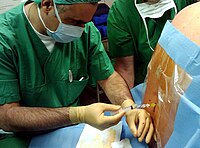
Photo from wikipedia
This manuscript is a narrative review of peer-reviewed studies of postdural puncture headache (PDPH) as the most common complication of a diagnostic and therapeutic lumbar puncture (LP) and LP due… Click to show full abstract
This manuscript is a narrative review of peer-reviewed studies of postdural puncture headache (PDPH) as the most common complication of a diagnostic and therapeutic lumbar puncture (LP) and LP due to the damage of the dura mater in epidural anesthesia. Author searched articles related to the PDPH and its risk factors, pathophysiology diagnosis, differential diagnosis, and therapy. All studies according to the analyzed parameters and their relevance to the clinical practice, as well as quality of the study methods, were selected for further analysis. The review presents the clinical and paraclinical prediction criteria for the onset, clinical features, course, and efficiency of specific therapeutic interventions which are of a particular clinical benefit for the prevention, pathogenetic treatment, and differential diagnosis of PDPH. The analysis of prediction parameters for the onset, clinical course, and associated symptoms and signs of PDPH is a contribution to the understanding of pathophysiology of intracranial hypotension, since PDPH can be considered a clinical model of intracranial hypotension. Given that LP is a common procedure in clinical practice, it is necessary to have a comprehensive knowledge of the risk factors, pathophysiological, diagnostic, differentially diagnostic, and therapeutic aspects of PDPH.
Journal Title: Neurological Sciences
Year Published: 2020
Link to full text (if available)
Share on Social Media: Sign Up to like & get
recommendations!